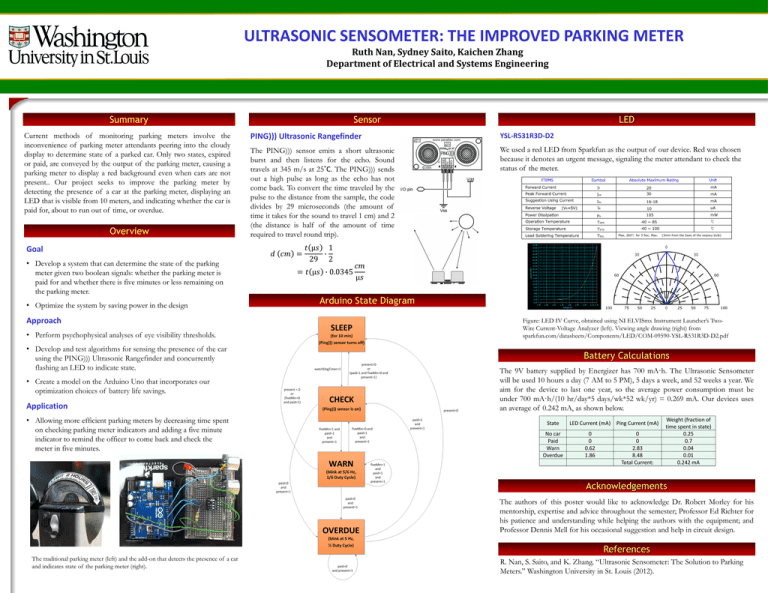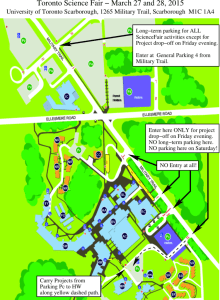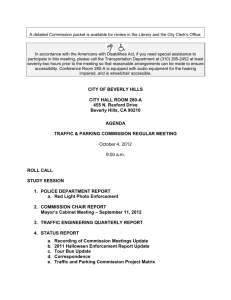poster2 - Department of Electrical and Systems Engineering
advertisement

ULTRASONIC SENSOMETER: THE IMPROVED PARKING METER Ruth Nan, Sydney Saito, Kaichen Zhang Department of Electrical and Systems Engineering Summary Current methods of monitoring parking meters involve the inconvenience of parking meter attendants peering into the cloudy display to determine state of a parked car. Only two states, expired or paid, are conveyed by the output of the parking meter, causing a parking meter to display a red background even when cars are not present.. Our project seeks to improve the parking meter by detecting the presence of a car at the parking meter, displaying an LED that is visible from 10 meters, and indicating whether the car is paid for, about to run out of time, or overdue. Overview Goal • Develop a system that can determine the state of the parking meter given two boolean signals: whether the parking meter is paid for and whether there is five minutes or less remaining on the parking meter. • Optimize the system by saving power in the design Approach • Perform psychophysical analyses of eye visibility thresholds. • Develop and test algorithms for sensing the presence of the car using the PING))) Ultrasonic Rangefinder and concurrently flashing an LED to indicate state. • Create a model on the Arduino Uno that incorporates our optimization choices of battery life savings. Application • Allowing more efficient parking meters by decreasing time spent on checking parking meter indicators and adding a five minute indicator to remind the officer to come back and check the meter in five minutes. Sensor LED PING))) Ultrasonic Rangefinder YSL-R531R3D-D2 The PING))) sensor emits a short ultrasonic burst and then listens for the echo. Sound travels at 345 m/s at 25˚C. The PING))) sends out a high pulse as long as the echo has not come back. To convert the time traveled by the pulse to the distance from the sample, the code divides by 29 microseconds (the amount of time it takes for the sound to travel 1 cm) and 2 (the distance is half of the amount of time required to travel round trip). We used a red LED from Sparkfun as the output of our device. Red was chosen because it denotes an urgent message, signaling the meter attendant to check the status of the meter. 𝑡 μ𝑠 1 𝑑 𝑐𝑚 = ∙ 29 2 𝑐𝑚 = 𝑡 μ𝑠 ∙ 0.0345 μ𝑠 Arduino State Diagram Figure: LED IV Curve, obtained using NI ELVISmx Instrument Launcher’s TwoWire Current-Voltage Analyzer (left). Viewing angle drawing (right) from sparkfun.com/datasheets/Components/LED/COM-09590-YSL-R531R3D-D2.pdf Battery Calculations The 9V battery supplied by Energizer has 700 mA·h. The Ultrasonic Sensometer will be used 10 hours a day (7 AM to 5 PM), 5 days a week, and 52 weeks a year. We aim for the device to last one year, so the average power consumption must be under 700 mA·h/(10 hr/day*5 days/wk*52 wk/yr) = 0.269 mA. Our devices uses an average of 0.242 mA, as shown below. State LED Current (mA) Ping Current (mA) No car Paid Warn Overdue 0 0 0.62 1.86 0 0 2.83 8.48 Total Current: Weight (fraction of time spent in state) 0.25 0.7 0.04 0.01 0.242 mA Acknowledgements The authors of this poster would like to acknowledge Dr. Robert Morley for his mentorship, expertise and advice throughout the semester; Professor Ed Richter for his patience and understanding while helping the authors with the equipment; and Professor Dennis Mell for his occasional suggestion and help in circuit design. References The traditional parking meter (left) and the add-on that detects the presence of a car and indicates state of the parking meter (right). R. Nan, S. Saito, and K. Zhang. “Ultrasonic Sensometer: The Solution to Parking Meters.” Washington University in St. Louis (2012).







